The WD Red Pro drives are created specifically for medium or large-scale business customers, supporting up to 24-bay NAS systems and built to handle heavy workloads in 24×7 environments. Looking at the WD Red Pro 22TB model for this review, these drives are perfect for archiving, sharing, and rebuilding RAID arrays on extended operating systems like ZFS or other file systems.
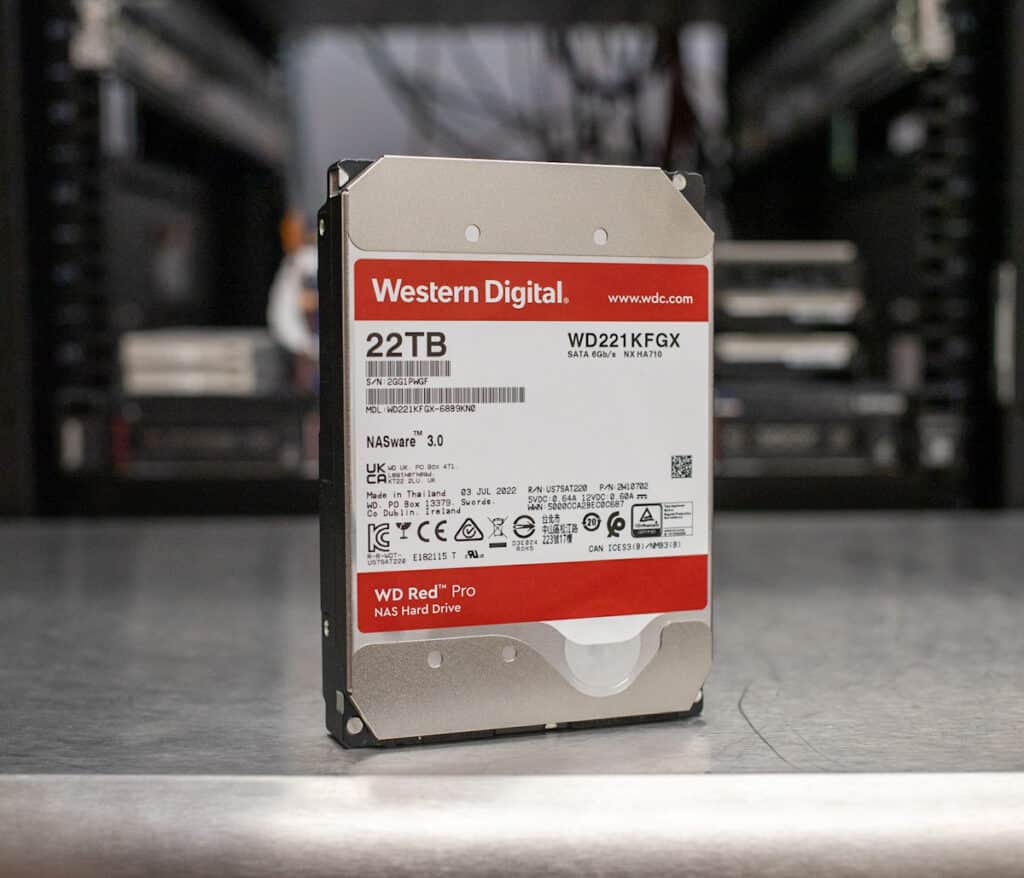
WD Red Pro 22TB
The WD Red Pro 22TB HDD is highlighted by NASware 3.0 technology, a technology that aims to improve the overall performance and reliability of the drive when used in a NAS environment. NASware 3.0 provides a range of benefits, such as seamless integration with NAS systems, robust data protection, and optimal performance even under heavy demand. This advanced technology also increases compatibility and upgradeability, making it work more efficiently when used inside a NAS. It also features a unique algorithm that balances performance and reliability in NAS and RAID environments, which means it’s one of the most compatible drives available for NAS enclosures.
In terms of protection, the drive is equipped with a multi-axis shock sensor that can detect subtle shock events, as well as dynamic fly height technology that adjusts read-write functions to compensate for and protect the data. This is particularly useful in larger 24-bay NAS environments, where the drive can be exposed to more vibration and movement.
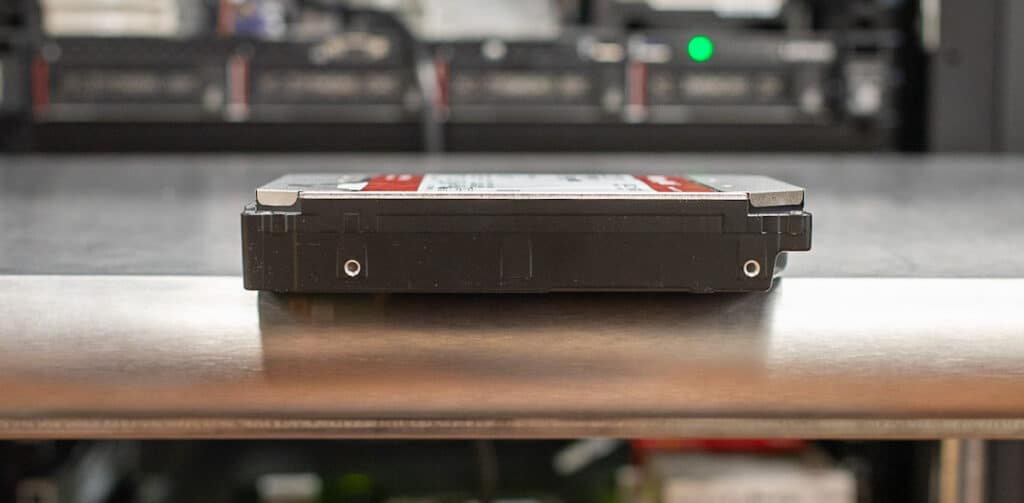
WD Red Pro 22TB Side
The drive also features enhanced dual-plane balance control technology, which improves overall drive performance and reliability. This is important in RAID and NAS environments, where unbalanced hard drives can cause excessive vibration and noise, reducing the lifespan of the drive and degrading performance over time. Additionally, the drive comes with error recovery controls as part of NASware 3.0 technology, to help reduce drive fallout in RAID applications.
As far as how it differs from other WD Red Pro capacities, there are a few specifications of note. For performance, it is quoted to deliver a transfer rate of 265MB/s. This is the same speed as the 10TB model, though it comes slightly behind the 20TB (268MB/s) and 18TB (272MB/s) models.
It also shows 6.8W for read/write, 3.4W for idle, and 1.2W for standby and sleep, which makes it one of the more power-hungry models of the Red Pro line. This is expected, as larger capacity hard drives traditionally have a higher power consumption; however, the difference is usually small and you will require fewer high-capacity HDDs compared to smaller models for your server, which actually will save on overall power consumption. This is especially the case with the massive 22TB WD Red Pro.
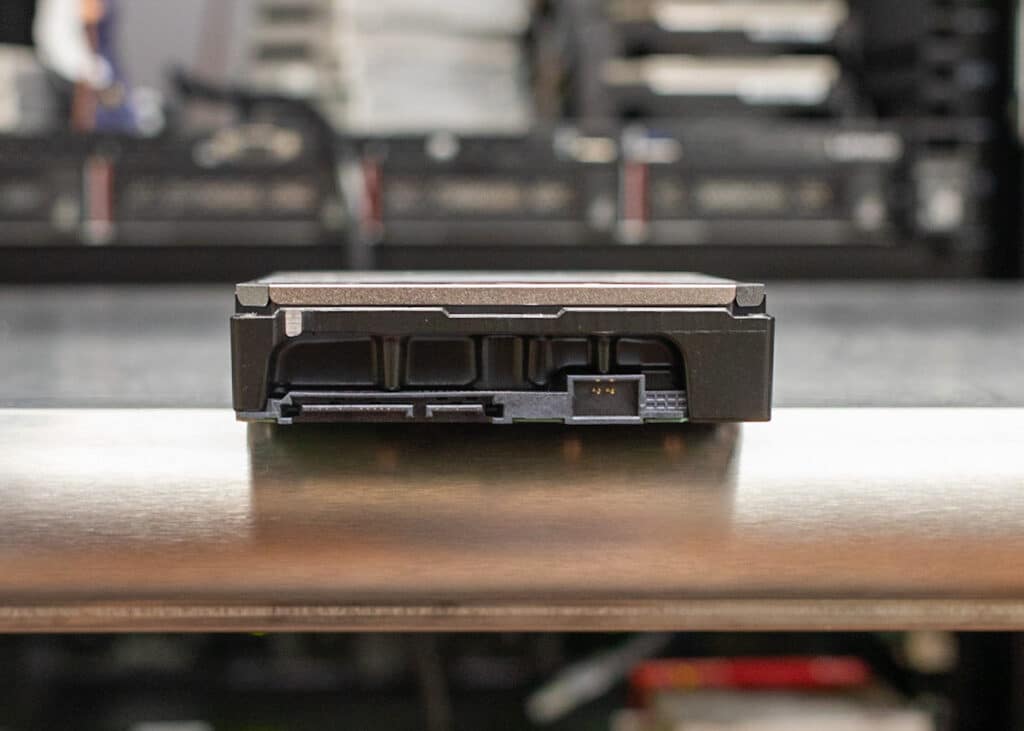
WD Red Pro 22TB Port
The Red Pro in 22TB is generally available with a street price at the time of this review of $499 at Amazon.
WD Red Pro 22TB HDD Specifications
| Model Number | WD221KFGX |
| Formatted capacity | 22TB |
| Recording technology | CMR |
| Interface | SATA 6 Gb/s |
| Form factor | 3.5-inch |
| Native command queuing | Yes |
| OptiNAND technology | Yes |
| Advanced Format (AF) | Yes |
| RoHS compliant | Yes |
| Performance | |
| Interface speed (max) | 6 Gb/s |
| Internal transfer rate | 265 MB/s |
| Cache (MB)1 | 512 |
| RPM | 7200 |
| Reliability/Data Integrity | |
| Load/unload cycles | 600,000 |
| Non-recoverable errors per bits read | <10 in 1014 |
| MTBF (hours) | 1,000,000 |
| Workload rate (TB/year) | 300 |
| Limited warranty (years) | 5 |
| Power Management | |
| 12VDC ±5% (A, peak) | 1.7 |
| 5VDC ±5% (A, peak) | |
| Average power requirements (W) | |
| Read/Write | 6.8 |
| Idle | 3.4 |
| Standby and Sleep | 1.2 |
| Environmental Specifications | |
| Temperature (°C) | |
| Operating
Non-operating |
0 to 65
-40 to 70 |
| Shock (Gs) | |
| Operating, (2 ms, read/write) Operating, (2 ms, read) Non-operating (2 ms) |
40
40 200 |
| Acoustics (dBA) | |
| Idle
Seek (average) |
20
32 |
| Physical Dimensions | |
| Height (in./mm, max) | 1.028/26.1 |
| Length (in./mm, max) | 5.787/147 |
| Width (in./mm, ± .01 in.) | 4/101.6 |
| Weight (lb/kg , ± 10%) | 1.48/0.67 |
WD Red HDD 22TB Performance
Enterprise Synthetic Workload Analysis
We will be gauging the WD Red Pro 22TB’s performance inside our QNAP TVS-h1288x (eight of the 12 drive bays drives configured in RAID6). We will be testing in both iSCSI and SMB protocols and comparing it to the WD Gold 22TB performance (which we populated inside the same QNAP NAS).
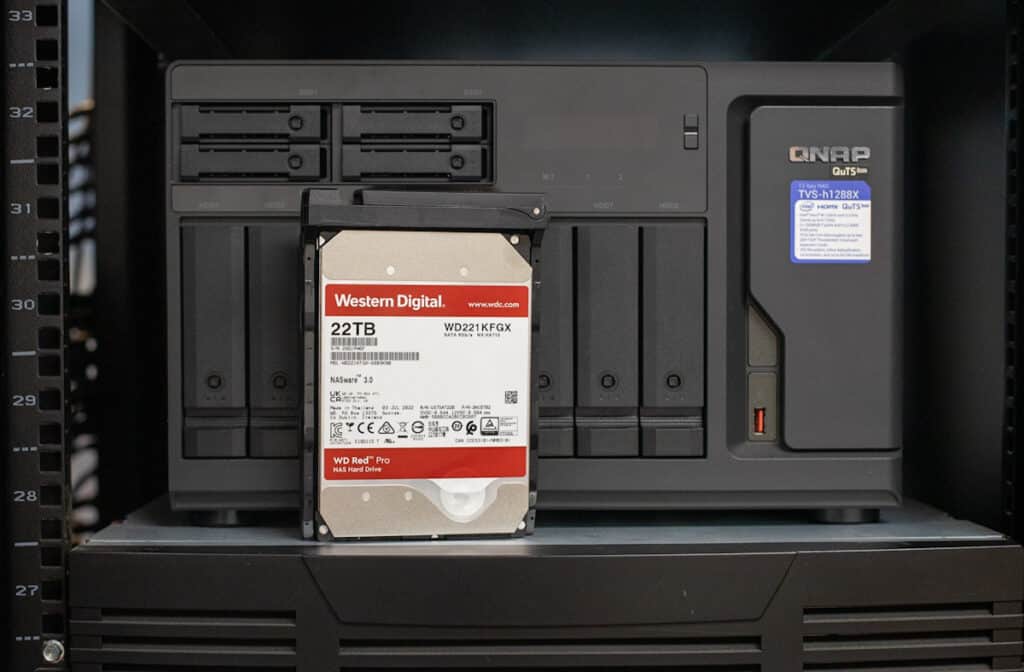
WD Red Pro 22TB with QNAP NAS
In general, the WD Gold line is designed for high-performance storage in enterprise environments, while the WD Red Pro line is meant for NAS systems (small to medium-sized businesses and home offices). Our QNAP TVS-h1288x is an SMB NAS system, designed specifically for drives like the Red Pro, so it will be interesting to see the difference in performance compared to the 22TB Gold.
Our enterprise hard drive benchmark process preconditions each drive-set into steady-state with the same workload the device will be tested with under a heavy load of 16 threads, with an outstanding queue of 16 per thread. The device is then tested in set intervals in multiple thread/queue depth profiles to show performance under light and heavy usage. Since hard drives reach their rated performance level very quickly, we only graph out the main sections of each test.
Preconditioning and Primary Steady-State Tests:
- Throughput (Read+Write IOPS Aggregate)
- Average Latency (Read+Write Latency Averaged Together)
- Max Latency (Peak Read or Write Latency)
- Latency Standard Deviation (Read+Write Standard Deviation Averaged Together)
Our Enterprise Synthetic Workload Analysis includes four profiles based on real-world tasks. These profiles have been developed to make it easier to compare to our past benchmarks, as well as widely-published values such as max 4K read and write speed and 8K 70/30, which is commonly used for enterprise drives.
4K
- 100% Read or 100% Write
- 100% 4K
8K 70/30
- 70% Read, 30% Write
- 100% 8K
128K (Sequential)
- 100% Read or 100% Write
- 100% 128K
Our first throughput test measures 4K random performance when inside the QNAP TVS-h1288x. Here, the WD Red Pro 22TB showed reads of 5,807 IOPS and 5,911 IOPS for SMB and iSCSI, respectively. Write activity showed 1,490 IOPS and 1,498IOPS. In comparison, the WD Gold 22TB posted similar performance read performance but noticeably weaker writes. Specifically, it posted 5,578 IOPS in reads and 804 IOPS write (SMB) and 5,774 IOPS read and 978 IOPS write (iSCSI).
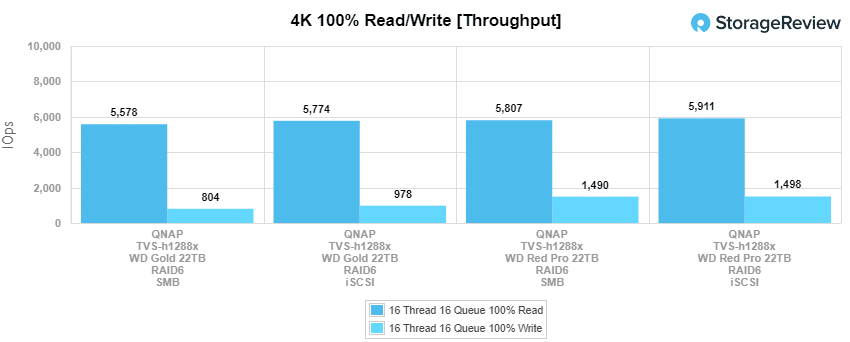
In average latency, WD Red Pro 22TB hit 44.08ms read and 172.4ms write in SMB and 43.3ms read and 170.5ms in iSCSI. The 22TB WD Gold was able to reach read and writes of 45.9ms and 318.2ms, respectively, in SMB, while iSCSI posted 44.3ms read and 261.44ms write.
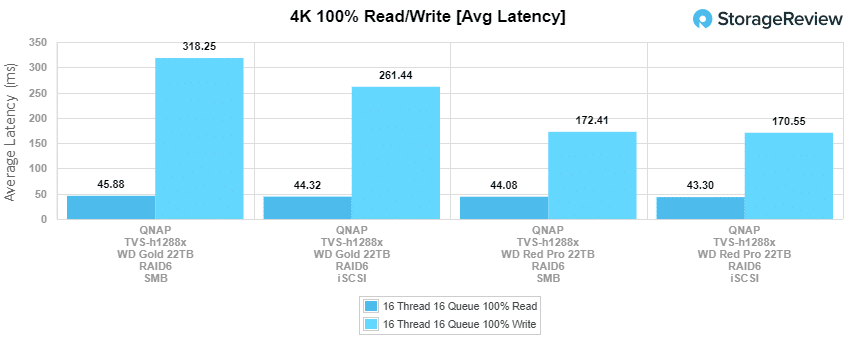
Moving on to the max latency, the WD Red Pro again showed superior performance inside the QNAP NAS, posting 665ms read and 2,683ms write (SMB) and 719.8ms read and 20,080ms write (iSCSI). The WD Gold hit 2,188.9ms read and 17,492ms write in SMB, while the reaching 802.88ms read and 6,647ms write in iSCSI.
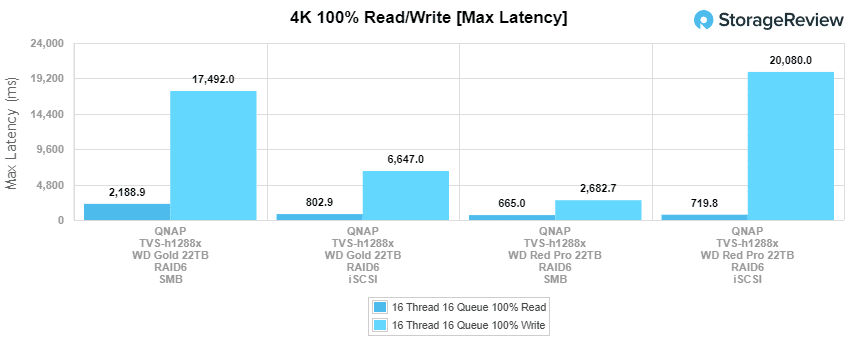
For standard deviation, the WD Red Pro 22TB recorded 40ms read and 1,075ms write (SMB) and 44.9ms read and 204ms write (iSCSI) while the WD Gold recorded 40ms read and 1,075.1ms write in SMB, and 44.86ms read and 203.95ms write in iSCSI.
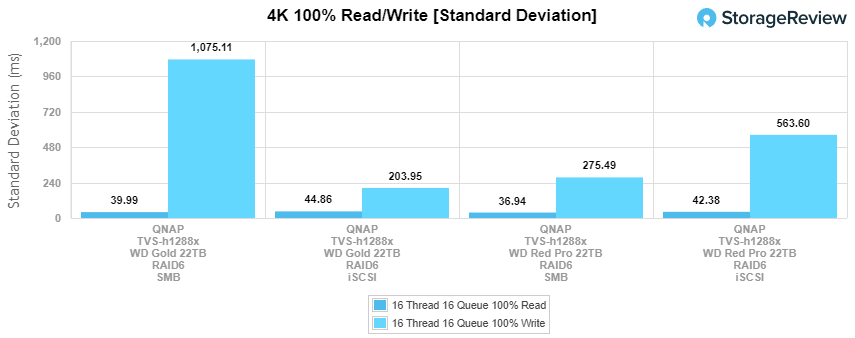
Our next benchmark subjects the drives to 100% read and write activity at 8K sequential throughput. When I inside the QNAP TVS-h1288x, the WD Red Pro 22TB posted 130,181 IOPS read and 69,904 write (SMB) and 190,762 IOPS read and 214,899 IOPS write (iSCSI). In comparison, the 22TB WD Gold drive showed 151,481 IOPS read and 96,064 IOPS write in SMB, while reaching 206,476 IOPS read and 142,538 IOPS write in iSCSI.
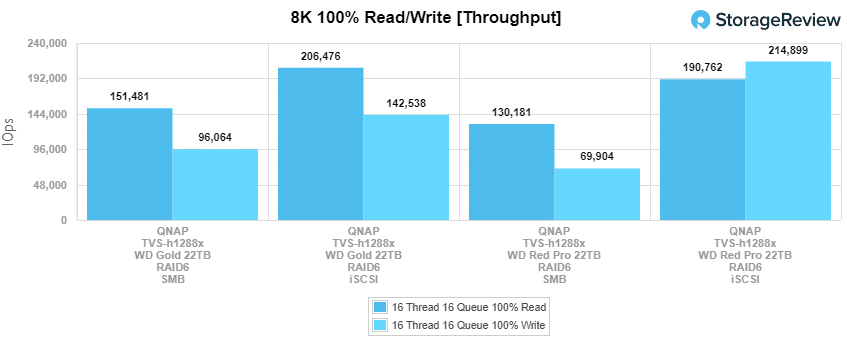
Up first is throughput, where Red Pro posted a range of 770 IOPS through 1,972 IOPS (SMB) in the terminal queue depths, while iSCSI showed 643 IOPS to 1,944 IOPS. The WD Gold 22TB had a range of 765 IOPS to 2,137 IOPS in SMB and 639 IOPS to 1,724 IOPS in iSCSI.
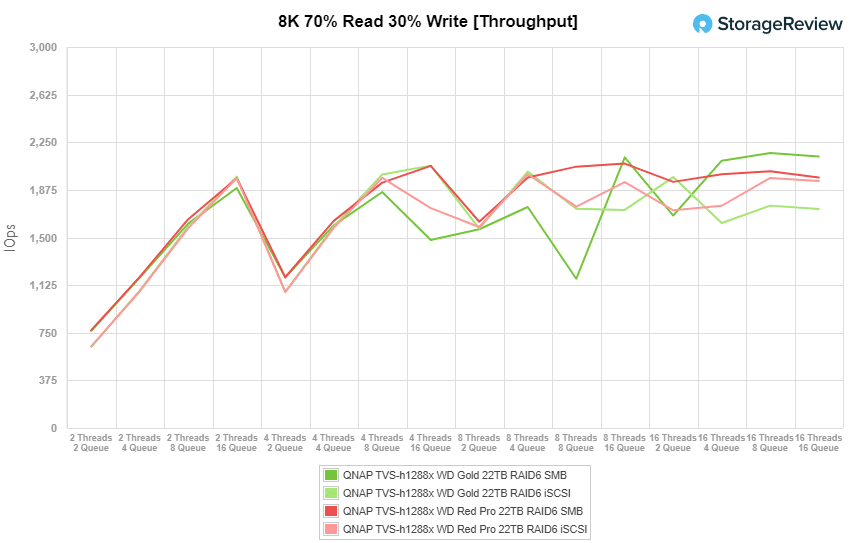
With average latency at 8K 70/30 using a QNAP TVS-h1288x, the 22TB Red Pro had a range of 5.19ms to 129.04ms (SMB) and 6.2ms to 131.69ms (iSCSI). The 22TB Gold 22TB posted 5.22ms through 118.83ms in SMB, while iSCSI recorded a range of 6.25ms through 148.32ms.
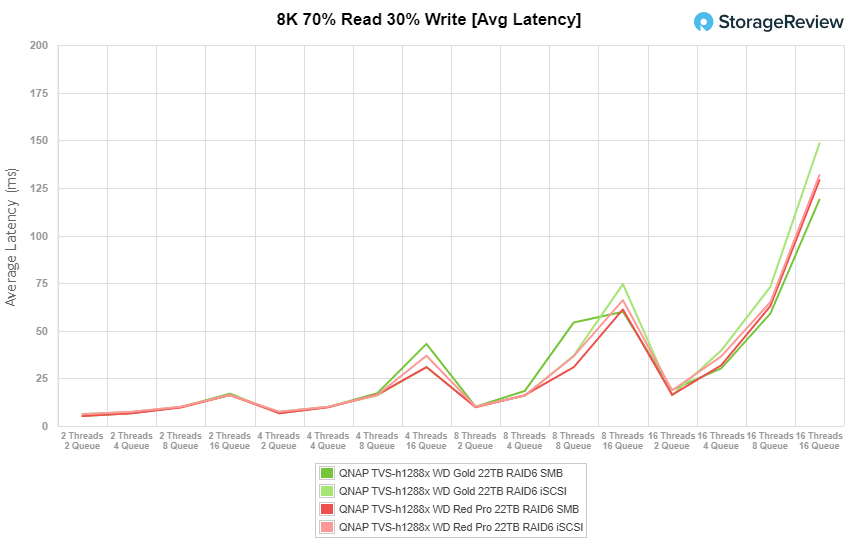
Moving on to max latency numbers, the 22TB Red Pro ranged from 1,396ms to 4,604ms (SMB) and 498ms to 2,003ms (iSCSI). In comparison, the 22TB WD Gold had a range of 1,713.61ms to 6,979.94ms in SMB while the iSCSI showed 500.01ms through 7,080.62ms.
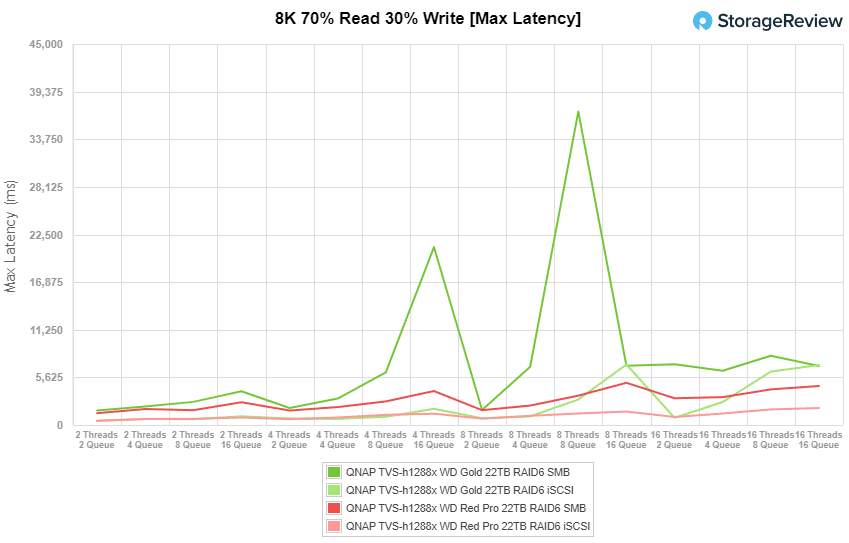
For our standard deviation latency results, 22TB Red Pro had a range of 19.18ms to 28.18ms (SMB) and 12.29ms to 150.22ms (iSCSI). The 22TB Gold hit 20.99ms through 283.28ms (SMB) and 12.56ms to 307.77ms (iSCSI).
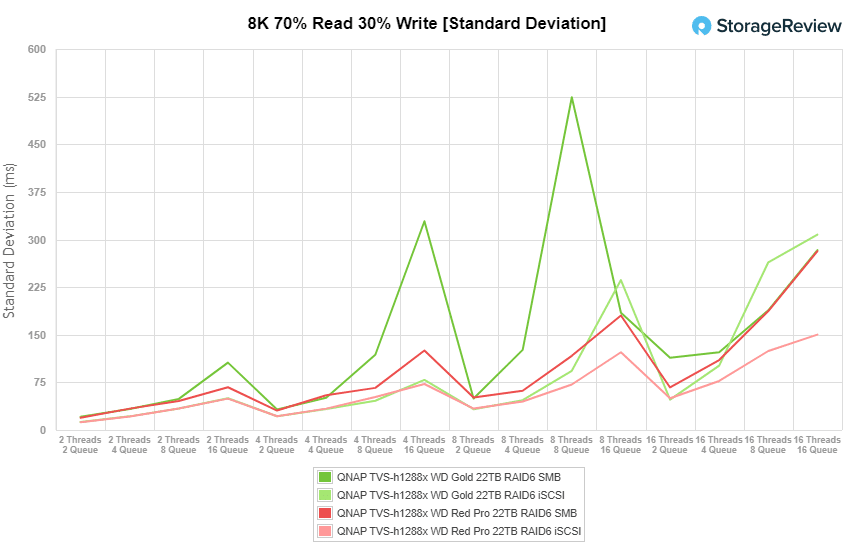
Our last test is the 128K benchmark, a large-block sequential test showing the highest sequential transfer speed. Here, the Red Pro drive recorded 2.31GB/s read and 2.28GB/s write in SMB, while iSCSI recorded 2.27GB/s read and 2.31GB/s write. The WD Gold 22TB posted noticeably slower results, with 1.03GB/s read and 947MB/s write in SMB, and 1.37GB/s read and an impressive 2.31GB/s write in iSCSI.
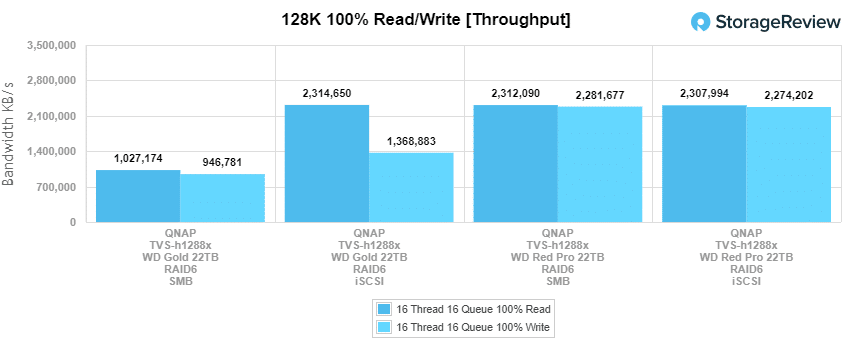
Conclusion
The WD Red Pro 22TB HDD is the largest capacity model from the popular line of drives specifically designed for medium to large-scale businesses. With support for up to 24-bay NAS systems, it had a solid showing during our benchmarking, making it a great option for heavy workloads in 24×7 environments. It also features NASware 3.0 technology, which improves the overall performance and reliability of the drive when used in a NAS environment.
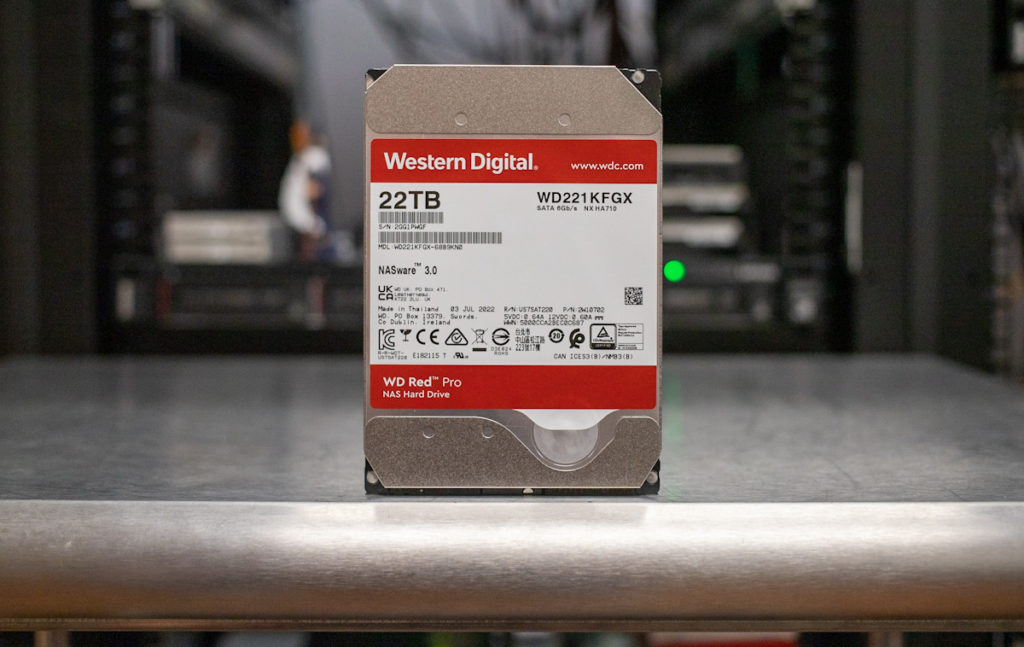
WD Red Pro 22TB
The drive is also equipped with enhanced dual-plane balance control technology, which improves overall drive performance and reliability, and comes with error recovery controls to help reduce drive fallout in RAID applications. That said, the drive has (expectedly) higher power consumption compared to most of the other Red Pro capacities, with quoted readings of 6.8W for read/write, 3.4W for idle, and 1.2W for standby and sleep.
In terms of performance, we installed eight of these drives in our QNAP TVS-h1288x (eight of the 12 drive bays drives configured in RAID6) and compared them alongside a set of WD’s 22TB Gold HDDs for reference. While the WD Gold uses the same configuration as the WD Red Pro 22TB, it is designed more for high-performance storage in enterprise environments.
Nonetheless, we saw some pretty impressive results across all our benchmarking with the 22TB Red Pro, including reads of 5,807 IOPS (SMB) and 5,911 IOPS (iSCSI) writes of 1,490 IOPS (SMB) and 1,498IOPS (iSCSI) in random 4K. In addition, we recorded 130,181 IOPS read and 69,904 write (SMB) and 190,762 IOPS read and 214,899 IOPS write (iSCSI) during our 100% read and write activity at 8K sequential workload. We also saw solid performance in our 8K 70/30 workload with a range of 770 IOPS through 1,972 IOPS (SMB) and 643 IOPS to 1,944 IOPS (iSCSI). In our large-block sequential 128K test, the Red Pro drive recorded 2.31GB/s read and 2.28GB/s write in SMB, while iSCSI recorded 2.27GB/s read and 2.31GB/s write.
Like the other capacities before it, the WD Red Pro 22TB is one of the most reliable drives available for NAS enclosures. These drives are perfect for businesses that require a large-capacity drive for their medium or large-scale NAS systems and need efficient data protection and solid performance. Because of its massive 22TB capacity, NAS solutions are able to store more data in a single drive, reducing the number of drives needed. The higher capacity also offers more efficient use of power and space, making them cost-effective and practical for large-scale storage solutions. All of this combined make the WD Red Pro 22TB a phenomenal choice for those focused on NAS density.




 Amazon
Amazon